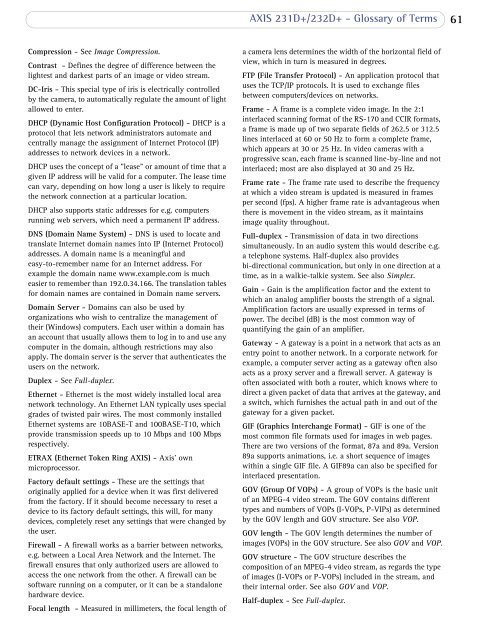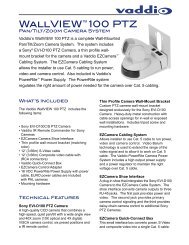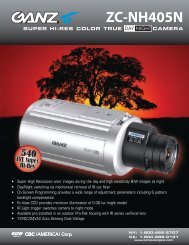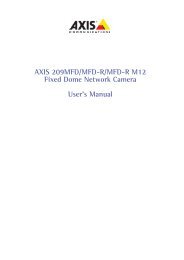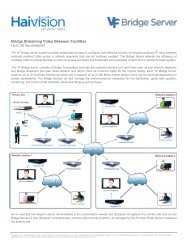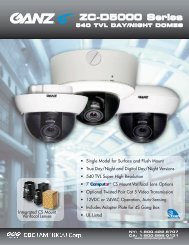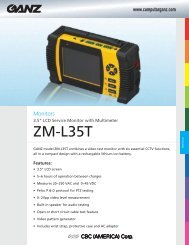AXIS 231D+/232D+ Network Dome Camera User's Manual
AXIS 231D+/232D+ Network Dome Camera User's Manual
AXIS 231D+/232D+ Network Dome Camera User's Manual
Create successful ePaper yourself
Turn your PDF publications into a flip-book with our unique Google optimized e-Paper software.
<strong>AXIS</strong> <strong>231D+</strong>/<strong>232D+</strong> - Glossary of Terms61Compression - See Image Compression.Contrast - Defines the degree of difference between thelightest and darkest parts of an image or video stream.DC-Iris - This special type of iris is electrically controlledby the camera, to automatically regulate the amount of lightallowed to enter.DHCP (Dynamic Host Configuration Protocol) - DHCP is aprotocol that lets network administrators automate andcentrally manage the assignment of Internet Protocol (IP)addresses to network devices in a network.DHCP uses the concept of a "lease" or amount of time that agiven IP address will be valid for a computer. The lease timecan vary, depending on how long a user is likely to requirethe network connection at a particular location.DHCP also supports static addresses for e.g. computersrunning web servers, which need a permanent IP address.DNS (Domain Name System) - DNS is used to locate andtranslate Internet domain names into IP (Internet Protocol)addresses. A domain name is a meaningful andeasy-to-remember name for an Internet address. Forexample the domain name www.example.com is mucheasier to remember than 192.0.34.166. The translation tablesfor domain names are contained in Domain name servers.Domain Server - Domains can also be used byorganizations who wish to centralize the management oftheir (Windows) computers. Each user within a domain hasan account that usually allows them to log in to and use anycomputer in the domain, although restrictions may alsoapply. The domain server is the server that authenticates theusers on the network.Duplex - See Full-duplex.Ethernet - Ethernet is the most widely installed local areanetwork technology. An Ethernet LAN typically uses specialgrades of twisted pair wires. The most commonly installedEthernet systems are 10BASE-T and 100BASE-T10, whichprovide transmission speeds up to 10 Mbps and 100 Mbpsrespectively.ETRAX (Ethernet Token Ring <strong>AXIS</strong>) - Axis' ownmicroprocessor.Factory default settings - These are the settings thatoriginally applied for a device when it was first deliveredfrom the factory. If it should become necessary to reset adevice to its factory default settings, this will, for manydevices, completely reset any settings that were changed bythe user.Firewall - A firewall works as a barrier between networks,e.g. between a Local Area <strong>Network</strong> and the Internet. Thefirewall ensures that only authorized users are allowed toaccess the one network from the other. A firewall can besoftware running on a computer, or it can be a standalonehardware device.Focal length - Measured in millimeters, the focal length ofa camera lens determines the width of the horizontal field ofview, which in turn is measured in degrees.FTP (File Transfer Protocol) - An application protocol thatuses the TCP/IP protocols. It is used to exchange filesbetween computers/devices on networks.Frame - A frame is a complete video image. In the 2:1interlaced scanning format of the RS-170 and CCIR formats,a frame is made up of two separate fields of 262.5 or 312.5lines interlaced at 60 or 50 Hz to form a complete frame,which appears at 30 or 25 Hz. In video cameras with aprogressive scan, each frame is scanned line-by-line and notinterlaced; most are also displayed at 30 and 25 Hz.Frame rate - The frame rate used to describe the frequencyat which a video stream is updated is measured in framesper second (fps). A higher frame rate is advantageous whenthere is movement in the video stream, as it maintainsimage quality throughout.Full-duplex - Transmission of data in two directionssimultaneously. In an audio system this would describe e.g.a telephone systems. Half-duplex also providesbi-directional communication, but only in one direction at atime, as in a walkie-talkie system. See also Simplex.Gain - Gain is the amplification factor and the extent towhich an analog amplifier boosts the strength of a signal.Amplification factors are usually expressed in terms ofpower. The decibel (dB) is the most common way ofquantifying the gain of an amplifier.Gateway - A gateway is a point in a network that acts as anentry point to another network. In a corporate network forexample, a computer server acting as a gateway often alsoacts as a proxy server and a firewall server. A gateway isoften associated with both a router, which knows where todirect a given packet of data that arrives at the gateway, anda switch, which furnishes the actual path in and out of thegateway for a given packet.GIF (Graphics Interchange Format) - GIF is one of themost common file formats used for images in web pages.There are two versions of the format, 87a and 89a. Version89a supports animations, i.e. a short sequence of imageswithin a single GIF file. A GIF89a can also be specified forinterlaced presentation.GOV (Group Of VOPs) - A group of VOPs is the basic unitof an MPEG-4 video stream. The GOV contains differenttypes and numbers of VOPs (I-VOPs, P-VIPs) as determinedby the GOV length and GOV structure. See also VOP.GOV length - The GOV length determines the number ofimages (VOPs) in the GOV structure. See also GOV and VOP.GOV structure - The GOV structure describes thecomposition of an MPEG-4 video stream, as regards the typeof images (I-VOPs or P-VOPs) included in the stream, andtheir internal order. See also GOV and VOP.Half-duplex - See Full-duplex.


